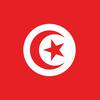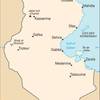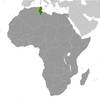Tunisia [+]Compare [E]dit [H]istory
Aliases: Al Jumhuriyah at Tunisiyah, Republic of Tunisia, TunisObject «Tunisia» was created due to
Add new object to «Tunisia» or move existing objects here.
Object «Tunisia» has attributes [Show empty attributes][Hide empty attributes]
| Attribute | Value |
|---|---|
| Geography | |
| Area | 163,610 km² |
| Continent | Africa |
| Land area | 155,360 km² |
| Water area | 8,250 km² |
| Land boundaries | 1,495 km |
| Border countries |
|
| Coastline | 1,148 km |
| Mean elevation | 246 m |
| Lowest point | -17 m |
| Highest point | 1,544 m |
| People | |
| Population | 11,721,177 |
| Official languages |
|
| Religion | Muslim |
| Government | |
| Long country name | Republic of Tunisia |
| Short country name | Tunisia |
| Long local name | Al Jumhuriyah at Tunisiyah |
| Short local name | Tunis |
| Former name | Add |
| Government type | Parliamentary republic |
| Capital | Tunis |
| Economy | |
| GDP (PPP) | 137,700,000,000 USD |
| GDP (OER) | 39,960,000,000 USD |
| GDP (real growth rate) | 2 % |
| GDP - per capita (PPP) | 11,900 USD |
| Gross national saving | 12 % of GDP |
| Labor force | 4,054,000 |
| Unemployment rate | 15.5 % |
| Population below poverty line | 15.5 % |
| Budget revenues | 9,876,000,000 USD |
| Budget expenditures | 12,210,000,000 USD |
| Military expenditures | 2.09 % of GDP |
| Taxes and other revenues | 24.7 % of GDP |
| Budget surplus or deficit | -5.8 % of GDP |
| Public debt | 70.3 % of GDP |
| Inflation rate | 5.3 % |
| Central bank discount rate | 5.75 % |
| Commercial bank prime lending rate | 7.31 % |
| Stock of narrow money | 12,920,000,000 USD |
| Stock of broad money | 12,920,000,000 USD |
| Stock of domestic credit | 36,190,000,000 USD |
| Market value of publicly traded shares | 8,887,000,000 USD |
| Current account balance | -4,191,000,000 USD |
| Exports | 13,820,000,000 USD |
| Imports | 19,090,000,000 USD |
| Reserves of foreign exchange and gold | 5,594,000,000 USD |
| External debt | 30,190,000,000 USD |
| National currency | Tunisian dinars |
| National currency (code) | TND |
| National currency (symbol) | د.ت |
| National currency rate to USD | 2.48 |
Rivalry between French and Italian interests in Tunisia culminated in a French invasion in 1881 and the creation of a protectorate. Agitation for independence in the decades following World War I was finally successful in convincing the French to recognize Tunisia as an independent state in 1956. The country's first president, Habib BOURGUIBA, established a strict one-party state. He dominated the country for 31 years, repressing Islamic fundamentalism and establishing rights for women unmatched by any other Arab nation. In November 1987, BOURGUIBA was removed from office and replaced by Zine el Abidine BEN ALI in a bloodless coup. Street protests that began in Tunis in December 2010 over high unemployment, corruption, widespread poverty, and high food prices escalated in January 2011, culminating in rioting that led to hundreds of deaths. On 14 January 2011, the same day BEN ALI dismissed the government, he fled the country, and by late January 2011, a "national unity government" was formed. Elections for the new Constituent Assembly were held in late October 2011, and in December, it elected human rights activist Moncef MARZOUKI as interim president. The Assembly began drafting a new constitution in February 2012 and, after several iterations and a months-long political crisis that stalled the transition, ratified the document in January 2014. Parliamentary and presidential elections for a permanent government were held at the end of 2014. Beji CAID ESSEBSI was elected as the first president under the country's new constitution. CAID ESSEBSI’s term, as well as that of Tunisia’s 217-member Parliament, expires in 2019.
Similar objects
Most often compared with
Everyone can something to edit or add.
There was one edit, no edits waiting approval. Last edited by mann.zelma(9435), Sep 16, 2019 (63 fields were changed)
Help · Contact us · Disclaimer · Contributors · Developers · Donate


